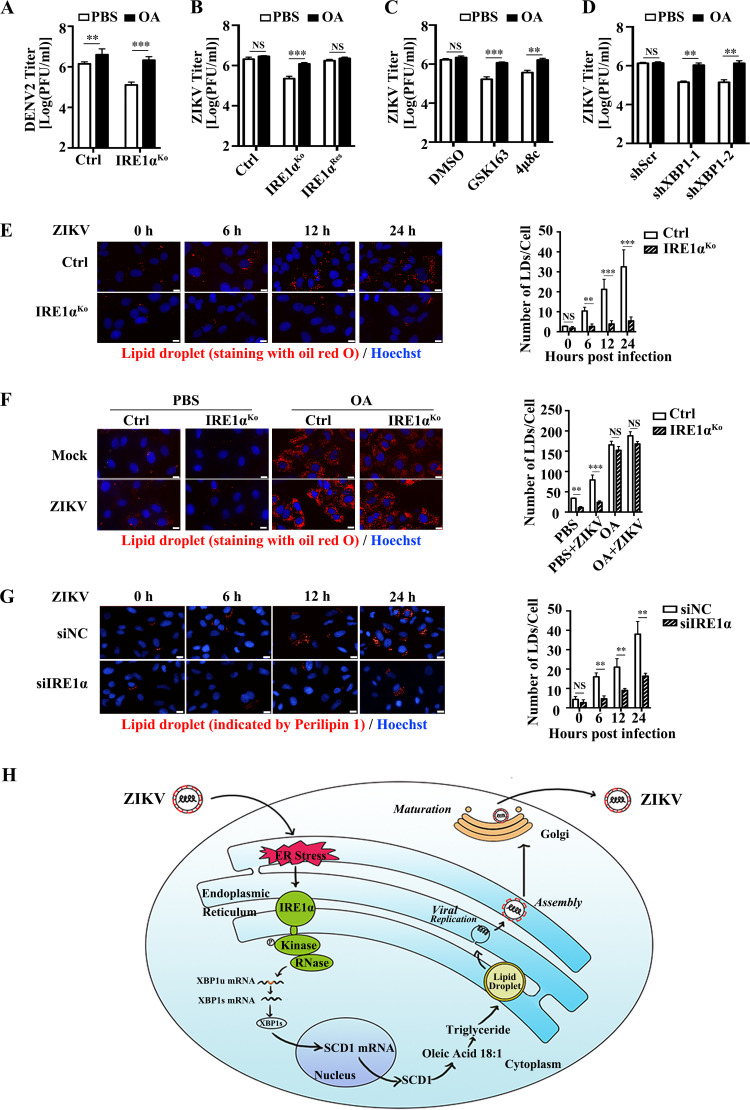FIG 6.
IRE1α promotes ZIKV replication through modulating oleic acid and lipid droplet production. (A) Impact of oleic acid (OA) on DENV2 titers. Control cells and IRE1αKo cells were infected with DENV2 at an MOI of 3, followed by OA (50 μM) addition at 1 h p.i. The supernatants were collected at 24 h p.i. for plaque assay. (B) Impact of OA on ZIKV titers. Control cells, IRE1αKo cells, and IRE1αRes cells were infected with ZIKV at an MOI of 3. Then, 50 μM OA was added at 1 h p.i. The supernatants were collected at 24 h p.i. for plaque assay. (C) Effect of OA on viral titers in IRE1α inhibitor-treated cells. A549 cells were treated with 30 μM GSK163 or 4μ8c. Then, the cells were infected with ZIKV at 1 h posttreatment, followed by 50 μM OA addition at 1 h p.i. The supernatants were collected at 24 h p.i. for plaque assay. (D) Impact of OA on ZIKV titers in XBP1-deficient cells. shScr-, shXBP1-1-, and shXBP1-2-expressing cells were infected with ZIKV at an MOI of 3, followed by 50 μM OA addition. The supernatants were collected at 24 h p.i. for plaque assay. (E) Production of lipid droplets in IRE1αKo cells. Control cells and IRE1αKo cells were infected with ZIKV at an MOI of 3 and harvested at 0, 6, 12, and 24 h p.i. for staining with oil red O or Hoechst to visualize lipid droplets or the nucleus, respectively. At least 200 cells from each sample in three independent experiments were counted. The scale bar represents 20 μm. (F) Impact of OA on lipid droplet production in IRE1αKo cells. Control cells and IRE1αKo cells were infected with ZIKV (MOI 3), followed by OA (50 μM) or the same volume of PBS addition at 1 h p.i. Then, the cells were harvested at 24 h p.i. for the staining with oil red O or Hoechst to visualize lipid droplet or the nucleus, respectively. At least 200 cells from each sample in three independent experiments were counted. The scale bar represents 20 μm. (G) Production of lipid droplets in IRE1α knockdown cells. HepG2 cells were transfected with IRE1α-specific siRNAs for 48 h and then infected with ZIKV at an MOI of 3. Cells were fixed at 0, 6, 12, and 24 h p.i. and processed for immunofluorescence microscopy for detection of lipid droplet protein perilipin 1 (red) and Hoechst (blue). At least 200 cells from each sample in three independent experiments were counted. Scale bar, 20 μm. (H) A proposed model to show the mechanism of IRE1α promoting ZIKV replication. In response to ZIKV infection, IRE1α is activated and splices the XBP1 mRNA, which enhances the expression of SCD1 and subsequent lipid droplet production, ultimately promoting virus replication. Data are representative of those from three independent experiments. **, P < 0.01; ***, P < 0.001 (two-tailed Student t test).

